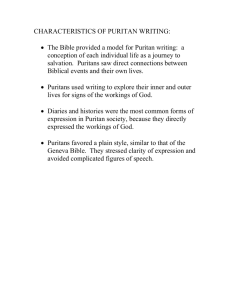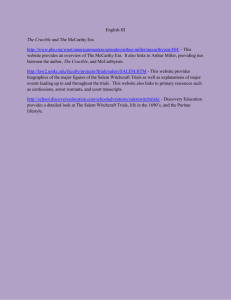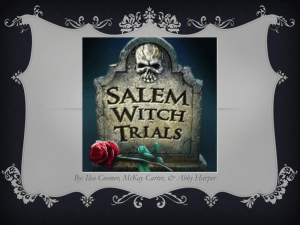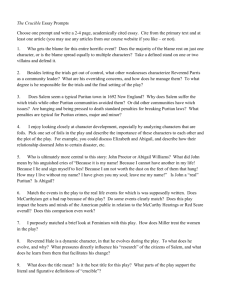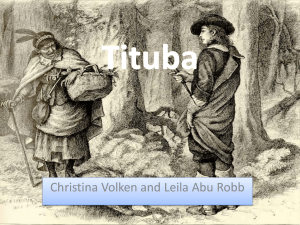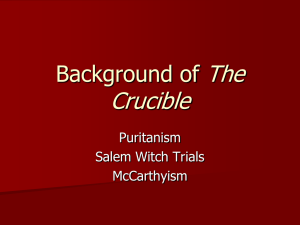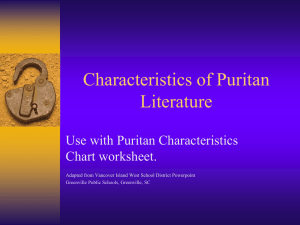The Puritans
advertisement
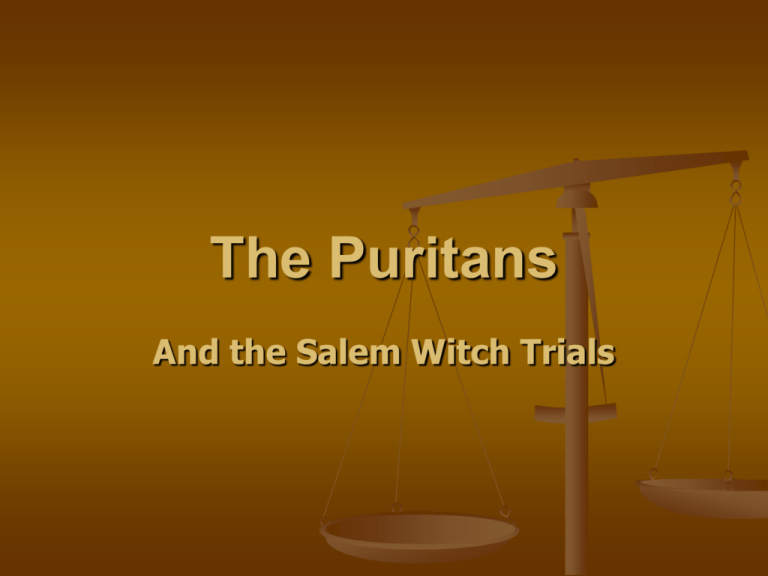
The Puritans And the Salem Witch Trials The Puritans The roots of Puritanism are to be found in the beginnings of the English Reformation. The name "Puritans" (they were sometimes called "precisionists") was a term of contempt assigned to the movement by its enemies. Puritanism developed in the 1530s, when King Henry VIII repudiated papal authority and transformed the Church of Rome into a state Church of England. But the Church of England retained much of the liturgy and ritual of Roman Catholicism and seemed, to many dissenters, to be insufficiently reformed. History It stressed the pastoral responsibility of the clergy and thus placed an unprecedented emphasis on the sermon as the central rite of religious life. Some put an end to kneeling at communion, to the ceremonial marriage ring, to crossing the child in baptism. Puritans did not believe that the preaching ministry had to come from superior church officers, who in turn claimed their legitimacy through the chain of apostolic succession. History Continued… They believed, instead, that a true church was a continually renewed collective act of "edification"—a mutually committed group of believers from whose ranks arose a mandate for a pastoral minister to serve them. God spoke primarily through the preaching ministry, not through the sacraments. What Was Their Doctrine? Puritans adhered to the Five Points of Calvinism as codified at the Synod of Dort in 1619 (1) Unconditional Election: the idea that God had decreed who was damned and who was saved from before the beginning of the world (2) Limited Atonement: the idea that Christ died for the elect only (3) Total Depravity : humanity's utter corruption since the Fall (4) Irresistible Grace: regeneration as entirely a work of God, which cannot be resisted and to which the sinner contributes nothing (5) The Perseverance of the Saints: the elect, despite their backsliding and faintness of heart, cannot fall away from grace SERMONS What most stirred the exasperation of the Anglican establishment was their devotion to sermons, "not Sermons read neither ... but sermons without book, sermons which spend their life in their birth and may have public audience but once." So that the "meanest understanding" could grasp them, these sermons were increasingly delivered in a "plain style"; they were long, frequent, and likely to stray from traditional biblical subjects and raise such questions as the mutual obligations of debtors and creditors. At heart, Puritan sermons were passionate appeals for conversion. They stressed a process of self-examination by which the inner corruption of the soul could be exposed and for which God, at his own pleasure, might forgive the penitent sinner. The great paradox for Puritan believers—which was raised to even higher pitch in New England—was their simultaneous striving for self-knowledge and acknowledgment of the infinity of their ignorance. A Puritan might hear, in a pious lifetime, hundreds of sermons proclaiming God's inscrutability and the futility of human effort to do anything to affect God's will. Yet virtually the only hope for salvation was to submit to this auditory form of the saving word and to pray that the holy spirit would enter the soul through the imprecatory voice of the minister. Migration to America Separatist believers in the Yorkshire village of Scrooby, who, fearing for their safety, moved to Holland in 1608 and thence, in 1620, to the place they called Plymouth in New England. A decade later, a larger, better-financed group, mostly from East Anglia, migrated to Massachusetts Bay. There they set up gathered churches on much the same model as the transplanted church at Plymouth (with deacons, preaching elders, and, though not right away, a communion restricted to full church members, or "saints"). These Puritans called themselves "nonseparating congregationalists," by which they meant that they had not repudiated the Church of England as a false church. But in practice they acted—from the point of view of Episcopalians and even Presbyterians at home—exactly as the separatists were acting. Massachusetts By the 1640s their enterprise at Massachusetts Bay had grown to about ten thousand people. Through the inevitable centrifugal pressures of land scarcity within the borders of the swelling towns, ecclesiastical quarreling, and sheer restlessness of spirit, they had outgrown the bounds of the original settlement and spread into what would become Connecticut, New Hampshire, Rhode Island, and Maine, and eventually beyond the limits of New England. About the People The Puritan migration was overwhelmingly a migration of families (unlike other migrations to early America, which were composed largely of young unattached men). The literacy rate was high, and the intensity of devotional life, as recorded in the many surviving diaries, sermon notes, poems, and letters, was seldom to be matched in American life. The Puritans' ecclesiastical order was as intolerant as the one they had fled. Puritanism contained within itself the seed of its own fragmentation. Following hard upon the arrival in New England, dissident groups within the Puritan sect began to proliferate—Quakers, Antinomians, Baptists—fierce believers who carried the essential Puritan idea of the aloneness of each believer with an inscrutable God so far that even the ministry became an obstruction to faith. Conflicts Brewing The religious history of New England is shaped by the conflicts between congregational and synodcal authority. The conflicts began between those who stressed the utter helplessness of the individual in the process of salvation and those who began to allow a place for human initiative Between those who believed that the Lord's Supper was a sacrament reserved for the regenerate and those who believed that it could be a "converting ordinance"; Perhaps most divisively as time went on, between those who regarded baptism as a rite due only to the children of full communing church members and those who believed it could be safely extended to the children of "half-way" members— second-generation Puritans who had never stepped forward to make the profession of faith that the founders had required for entrance into the true church. Puritans Place in History Puritanism as a basic attitude was remarkably durable and can hardly be overestimated as a formative element of early American life. It furnished Americans with a sense of history as a progressive drama under the direction of God, in which they played a role akin to, if not prophetically aligned with, that of the Old Testament Jews as a new chosen people. Perhaps most important was the strength of Puritanism as a way of coping with the contradictory requirements of Christian ethics in a world on the verge of modernity. It supplied an ethics that somehow balanced the injunction to charity and the premium on self-discipline; it counseled moderation within a psychology that virtually ensured exertion toward worldly prosperity as the best sign of divine favor. Such an ethics was particularly urgent in a New World where opportunity can be as obvious as the source of moral authority is obscure. SALEM WITCH TRIALS The Origin During the colonial period, nearly three hundred women were accused by their neighbors of performing witchcraft. Although those accusations spanned approximately the first century of English settlement in North America, about half were voiced during one ten-month period in 1692. This episode is commonly known as the Salem witchcraft crisis, although it began in Salem Village (now Danvers), Massachusetts, a small settlement on the outskirts of Salem Town, and although most of the accused were from nearby Andover. Origin Continued… Many colonists in late-seventeenth-century New England combined their Puritan faith with a belief in witchcraft, and charges that one or another person was one of Satan's agents, bent on bringing harm to the community, were common. Massachusetts, in 1692 In February, a group of teenaged girls in Salem began experiencing spectacular fits, during which they thrashed about, wincing and shrieking. At first the girls blamed no one, but under repeated questioning by adults, they began to identify a widening circle of local residents as witches and wizards—mostly middle-aged women but also men and even one four-yearold child. Others in the surrounding area then also claimed to be the objects of sorcery, and the jails were soon crowded with accused men and women. Arrest followed arrest, but the fits increased. By the end of the summer, hundreds had been accused. A special court handled the trials, and by the time prosecutions ceased in May 1693, twenty-six people had been convicted and nineteen (including sixteen women) executed by hanging. Fifty more people confessed to being witches. Questioning the Trials Meanwhile, however, discomfort over the trials had been growing, both within Salem Village and in the wider community, including, among others, the Boston clergyman Increase Mather and the new governor, William Phips. Although few questioned the reality of witchcraft, many were troubled with the chaotic proceedings in Salem. In early October, the governor forbade further trials. In January 1693, he formed a new court, which, working under stricter evidentiary guidelines, acquitted forty-nine out of fifty-two prisoners; the rest were discharged by spring. Accusations of witchcraft decreased dramatically thereafter throughout New England. Why did it Happen? A number of historians have linked the witch trials to the painful changes that Puritan society was experiencing at the time. It also seems to have been generated in part by divisions within Salem Village that were magnified because local institutions were unable to resolve the conflicts satisfactorily. Torn between the communal asceticism of their original goals and the commercial individualism fast overtaking them, some Puritans responded with guilt and fear, seeking scapegoats on whom they could blame their sense of moral loss. Within Salem Village, a history of bitter factionalism (as well as resentment toward the more prosperous Salem Town, which controlled the village politically and ecclesiastically) may have helped make the witch-hunt in Salem Village the most virulent in New England.
